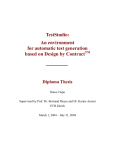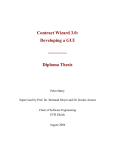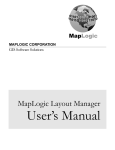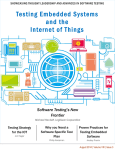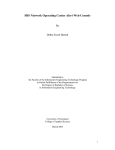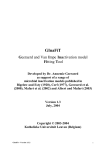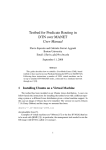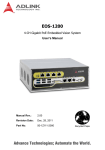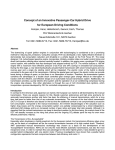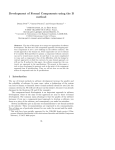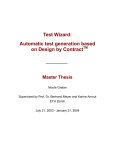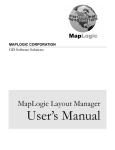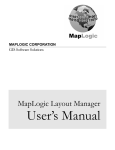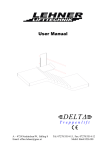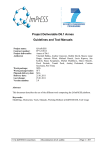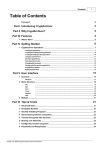Download An object-oriented library for event-driven design
Transcript
To be cited as follows: Bertrand Meyer, The power of abstraction, reuse and simplicity: an
object-oriented library for event-driven design, to appear in Festschrift in Honor of Ole-Johan
Dahl, eds. Olaf Owe et al., Springer-Verlag, Lecture Notes in Computer Science 2635, 2003.
The power of abstraction, reuse and simplicity:
An object-oriented library for event-driven design
ABSTRACT
A new library for event-driven design, defining a general and extendible scheme
yet easy to learn and use on both the publisher and subscriber sides, provides an
opportunity to analyze such other approaches as the “Observer Pattern”, the
event-delegate mechanism of .NET and its “Web Forms”, then to draw some
general software engineering lessons.
1 OVERVIEW
Event-driven software design avoids any direct connection, in a system’s
architecture, between the unit in charge of executing an operation and those in
charge of deciding when to execute it.
Event-driven techniques have gained growing usage because of their
flexibility. They are particularly common for Graphical User Interface
applications, where the operations come from an application layer and the
decision to execute them comes from a GUI layer in response to events caused
by human users. An event-driven scheme can shield the design of the
application layer from concerns related to the user interface. Many application
areas other than GUI design have used these ideas.
Closely related techniques have been proposed under such names as
Publish-Subscribe and Observer Pattern.
This article describes the Event Library, a reusable component solution
of broad applicability, covering all these variants. Intended to be easy to learn,
the library consists in its basic form of one class with two features, one for the
production of events and one for their consumption.
The discussion will compare this solution to the Observer Pattern and
mechanisms recently introduced by .NET. It will expand on this analysis to
examine more general issues of software engineering, including the role of
abstraction, the transition from design patterns to reusable components, the
concern for simplicity, and the contribution of object technology.
Section 2 quickly presents the essentials of the Event Library. Section 3
explains event-driven design and what makes it attractive. Sections 4, 5 and 6
analyze other solutions: the Observer Pattern, the .NET event handling
mechanism, the Web Forms library of ASP.NET. Section 7 gives the remaining
details of the Event Library. Section 8 examines the software engineering
issues that led to this work and draws general conclusions.
2
THE POWER OF ABSTRACTION, REUSE AND SIMPLICITY
2 EVENT LIBRARY ESSENTIALS
The Event Library consists at its core of one class, EVENT_TYPE with a
feature publish for publishers and a feature subscribe for subscribers. The
library is written in Eiffel; so are the usage examples in this section.
First the subscriber side. Assume you want to ensure that any future
mouse click will cause execution of a certain procedure of your application
your_procedure (a, b: INTEGER)
passing to it the mouse coordinates as values for a and b. To obtain this effect,
simply subscribe the desired procedure to the event type mouse_click:
.
mouse_click subscribe (agent your_procedure)
/1/
The argument to subscribe is an “agent” expression; an agent in Eiffel is an
object representing a routine, here your_procedure.
In most cases this is all one needs to know on the subscriber side, for
example to produce a graphical application using a GUI library. An advantage
of the scheme is that it lets you start from an existing system and add an eventdriven scheme such as a GUI without writing any connecting code. You’ll just
reuse the existing routines directly, linking them to event types through agent
expressions as above. This extends to routines with extra arguments: assuming
other_procedure ( text: STRING; a, b: INTEGER; date: DATE )
you can still subscribe the procedure without any “glue code” through
.
mouse_click subscribe (agent other_procedure ("TEXT", ?, ?, Today)
/2/
where the question marks indicate the values to be filled in by the event. (The
agent in form /1/ can be written more explicitly as agent your_procedure (?, ?).)
So much for subscribers. The basic scheme for publishers is also
straightforward. To trigger a mouse click event, all the GUI library will do is
.
mouse_click publish ([x_position, y_position])
/3/
It is also the publisher’s responsibility to declare mouse_click and create the
corresponding object. It can take care of both through
mouse_click: EVENT_TYPE [TUPLE [INTEGER, INTEGER]] is
once
create Result
end
/4/
3
§2 EVENT LIBRARY ESSENTIALS
Class EVENT_TYPE is generic; the parameter TUPLE [INTEGER, INTEGER]
indicates that a mouse click produces event data consisting of two integers,
representing the mouse coordinates, collected into a two-element “tuple”.
Since mouse_click just represents an ordinary object — an instance of
class EVENT_TYPE — the instruction that creates it could appear anywhere.
One possibility, as shown, is to put it in a “once function” defining mouse_click.
A once function is executed the first time it’s called, whenever that is, the same
result being returned by every subsequent call. This language mechanism
addresses the issue of providing initialization operations without breaking the
decentralized architecture of well-designed O-O systems. Here it creates the
mouse click object when first needed, and retains it for the rest of the execution.
The scheme as described covers global events: the subscriber call /1/
subscribes your_procedure to any mouse click anywhere. Instead we may want to
let subscribers select events in a given graphical element such as a button. We simply
turn mouse_click into a feature of class BUTTON, so that subscriber calls will be
.
.
your_button mouse_click subscribe (agent your_procedure)
.
/5/
perhaps clearer as your_button_click subscribe (agent your_procedure), retaining
the original form /1/ with your_button_click set to your_button mouse_click.
What we have just seen defines, for the majority of applications, the
user’s manual of the Event Library:
•
On the publisher side, declare and create the event type object; trigger a
corresponding event, when desired, by calling publish.
•
On the subscriber side, call subscribe with an agent for the desired routine.
Only one class is involved, EVENT_TYPE; there is no need to define specific
classes for each event type (mouse click, mouse movement etc.) as, for
example, in the .NET model studied below — although you can do so if you
wish by introducing descendants of EVENT_TYPE that specialize the event
data. There is also no need for the publishers or the subscribers to inherit from
any particular classes, such as the abstract classes SUBJECT and OBSERVER
of the Observer Pattern, also studied below.
Section 7 will describe some of the more specialized features of the
library. As is often the case when the basic design of a library uses a small
number of abstractions tailored to the problem, it is possible to add specialpurpose facilities without disturbing users who need only the basics.
To understand the rationale behind this design, we will now step back to
examine the general issues of event-driven computation, and some previously
proposed solutions.
.
4
THE POWER OF ABSTRACTION, REUSE AND SIMPLICITY
3 EVENT-DRIVEN DESIGN
Event-driven design offers interesting architectural solutions when execution
must respond to events whose order is hard to predict in the program text.
Putting the user in control
GUI and WUI (Web User Interfaces) provide the most immediately visible
illustration of why an event-driven scheme may be useful.
Consider this piece of WUI built with ASP.NET (the Web programming
library for .NET):
The interface that we show to our user includes a text field and a button. There
might be many more such “controls” (the Windows term for graphical
elements, called “widgets” in the X Window system). We expect that the user
will perform some input action, and we want to process it appropriately in our
program. The action might be typing characters into the text field, clicking the
button, or any other, such as menu selection, using controls not shown above.
But which of these will happen first? Indeed, will any happen at all?
We don’t know.
In the early days, the problem didn’t exist. Programs would just read user
input, using for example a loop to consume successive lines, as in
from
read_line
count := 0
until
last_line empty
loop
count := count + 1
-- Store last_line at position count in Result:
Result put (last_line, count)
read_line
end
.
.
[A]
§3 EVENT-DRIVEN DESIGN
This was good enough when we had a single sequential input medium and the
program was in charge of deciding when, where and how to enjoin the user to
enter some input, for example on a teletype console.
With current input techniques, a user sitting at a graphics workstation is
free at any time to go to the text field, the button or any other control. He, not
the program, is in control.
To support such modes of interaction, event-driven programming
replaces a control structure by a data structure. A control structure means that
the program decides when to execute things. Instead we want to let the user
decide what to do next. We’ll call these user decisions events. The system will
use a data structure — let’s call it the event-action table — to record in
advance the actions that it has to execute when events of specific types occur.
After that it relies on the event handling machinery to watch for events of
recognized types and, when detecting one of them, trigger the corresponding
action as found in the event-action table.
A role remains for control structures: each operation, while it executes,
defines the scheduling of its own operations, using a control structure that
can be arbitrarily complex. But when the operation terminates the eventdriven scheme takes over again.
Overall, it’s a major change. The program has relinquished direct control of
global execution scheduling to a generic table-driven mechanism. For best
results that mechanism should be a library, for example a GUI or WUI library,
or — more generic yet — the Event Library, not tied to any specific
application area.
This yields a clear division of tasks between such a general-purpose
library and any particular application. The application is in charge of
recording event-action associations; when the true show begins, the library is
in charge of catching and processing events.
Application authors have their say, since what gets executed in the end
are the actions — taken from the program — that they have planted in the
table. But they do not directly control the scheduling of steps.
The library owns the event-action table, so that application programmers
should not need to know anything about its implementation. With the Event
Library they simply record event-action associations, through calls to
subscribe; the library takes care of maintaining these associations in the
appropriate data structure. We’ll see that in some other frameworks, such as
.NET, programmers work at a lower level of abstraction, closer to the internal
representation of the event-action table.
5
6
THE POWER OF ABSTRACTION, REUSE AND SIMPLICITY
Publishers and subscribers
The overall scheme of programming in an event-driven style is this:
1 • Some part of the system is able to trigger events. We call it a publisher.
2 • Some part of the system wants to react to these events. We call it a
subscriber. (“Observer” would also do, as in the “Observer Pattern”,
where the publisher is called a “subject”.)
3 • The subscriber specifies actions that it wants to execute in connection
with events of specified types. We’ll say that the subscriber registers an
action for an event type. The effect of registration is to record an
association between an event type and a subscriber into the event-action
table. Registrations usually happen during initialization, but subscribers
can continue to register, or de-register, at any time of the execution; that’s
one of the advantages of using a table-driven scheme, since the table can
be modified at any time.
4 • At any time during execution proper, after initialization, the publisher can
trigger an event. This will cause execution of the routines that any
registered subscribers have associated with the event’s type.
For this discussion we must be careful about distinguishing between events
and event types. The notion of mouse click is an event type; a user clicking
his mouse will cause an event. Although the data structure is called the
event-action table for brevity, its definition clearly specified that it records
information about event types. Publishers, on the other hand, trigger events,
each of a certain type.
Healthy skepticism should lead us to ask why we need all this. Instead of an
indirect relationship through an event-action table, couldn’t we just skip step
3 and let, in step 4, the subscriber call the publisher, or conversely?
A subscriber can indeed call its publishers directly through a
generalization of the earlier sequential reading scheme: it will listen to events
of several possible types rather than just one, pick up the first one that happens,
select the appropriate action, and repeat. This has, however, two limitations.
One is that you need to put the subscriber in charge of the application’s control
structure; that is not always appropriate. Another, more serious, is that it is not
easy with this scheme to ensure that events raised by a publisher trigger
actions in several subscribers.
← [A], page 4.
7
§3 EVENT-DRIVEN DESIGN
Alternatively, the publisher could call the subscriber’s routine directly
.
my_subscriber routine (my_arguments)
using the standard object-oriented call mechanism. This works as long as the
whole scheme is static: the publishers know their subscribers, and this
information is defined once and for all so that publishers’ code can include
calls such as the above for each subscriber to each event type.
The limitations of both solutions indicate where event-driven
programming becomes interesting. We may picture the general situation as
one of those quantum physics experiments that bombard, with electrons or
other projectiles, some screen with a little hole:
PUBLISHERS
trigger events
SUBSCRIBERS
handle events
ROUTINE
EVENTS
ROUTINE
ROUTINE
The event-driven scheme decouples the subscribers from the publishers and
may be attractive if one or more of the following conditions hold:
Triggering and
handling
events
8
THE POWER OF ABSTRACTION, REUSE AND SIMPLICITY
•
Publishers can’t be required to know who the subscribers are: they
trigger events, but do not know who is going to process those events. This
is typically the case if the publisher is a GUI or WUI library: the routines
of the library know how to detect a user event such as a mouse click, but
they should not have to know about any particular application that reacts
to these events, or how it reacts. To an application, a button click may
signal a request to start a compilation, run the payroll, or shut down the
factory. To the GUI library, a click is just a click.
•
Subscribers may register and deregister while the application is running:
this generalizes the previous case by making the set of subscribers not
only unknown to publishers but also variable during execution.
•
Any event triggered by one publisher may be consumed by several
subscribers. For example the event is the change of a certain value, say a
temperature in a factory control system; then the change must be reflected
in many different places that “observe” it, for example an alphanumeric
display, a graphical display, and a database that records all historical
values. Without an event mechanism the publisher would have to call
routines in every one of these subscribers, causing too much coupling
between different parts of the system. This would mean, in fact, that the
publisher must know about all its subscribers, so this case also implies the
first one.
•
The subscribers shouldn’t need to know about the publishers: this is less
commonly required, but leads to the same conclusions.
In all such cases the event-driven style allows you to build a more flexible
architecture by keeping publishers and subscribers at bay.
There is a downside: if you are trying to follow the exact sequence of runtime operations — for example when debugging an application — you may
find the task harder, precisely because of the indirection. A plain call x f (…)
tells you exactly what happens: after the preceding instruction, control
transfers to f, until f’s execution terminates, and then comes back to the
instruction following the call. With an instruction that triggers an event, all you
know is that some subscribers may have registered some routines to handle
events of that kind, and if so they will execute these routines. But you don’t
immediately know who they are; indeed they may vary from execution to
execution. So it is more delicate to track what’s going on. One should weigh
this objection — which some authors have proposed to address by replacing
event-driven design with techniques inspired by parallel programming [18] —
before deciding to embark on an event-driven architecture.
.
9
§3 EVENT-DRIVEN DESIGN
Controls
In cases such as GUI and WUI programming, the event-action table will
generally contain not mere pairs — actions coupled with event types — but
triples: we don’t just specify “for events of this type, execute that action”, but
“for events of this type occurring in this control, execute that action”, as in:
•
“If the user clicks the EXIT button, exit the application”.
•
“If the mouse enters this window, change the border color to red ”.
•
“If this sensor reports a temperature above 40o C, ring the alarm”.
In the first case the control is a button and the event type is “mouse click”; in
the second, they are a window and “mouse enter”; in the third, a temperature
sensor and a measurement report.
A “control” is usually just a user interface element. As the last example
indicates, the concept also applies outside of the UI world.
A common library interface to let subscribers deposit triples into the
event-action table (we’ll continue to call it that way) uses calls of the
conceptual form
record_association (some_control, some_event_type, some_action)
/6/
and leaves the rest to the underlying GUI or WUI machinery. That’s the
essence of event-driven programming as supported by many modern graphics
toolkits, from Smalltalk to EiffelVision to the Windows graphical API and the
Web Forms of .NET. The most common variant is actually
add_association (some_control, some_event_type, some_action)
which adds some_action to the actions associated with some_event_type and
some_control, so that you can specify executing several actions for a given
event-control pair. We’ll retain the first form /6/ since it corresponds to the
most frequent need; it includes the second one as a special case if we assume
a provision for composite actions.
The Event Library seemed at first not to support controls since the basic
mechanism mouse_click subscribe (...) /1/ did not make them explicit; but
we saw that it’s just a matter of making an event type belong to a control
object, then use your_button mouse_click subscribe (...) /5/, which directly
provides the general scheme /6/.
.
.
.
10
THE POWER OF ABSTRACTION, REUSE AND SIMPLICITY
Actions as objects
In a classical O-O language, we have a problem. Even though we don’t need
to manipulate the event-action table directly, we know it will exist somewhere,
managed by a graphical library, and that it’s a data structure — a structure
made of objects, or (more realistically) references to objects. In each entry we
expect to find a triple containing references to:
•
One control.
•
One event type.
•
One action — or, as a result of the last observation, one list of actions.
Are these things objects? Controls, definitely. Any graphical O-O library
provides classes such as WINDOW and BUTTON whose instances are objects
representing controls — windows, buttons and so on. Event types too can be
defined as objects in an O-O language; we saw how the Event Library does it.
But what about actions?
Actions are given by our program’s code. In an O-O program, the natural
unit for an action is a routine of a class. But a routine is not an object.
This won’t be too much of a concern for a C++ programmer, who may
just use a function pointer: an integer denoting the address where a routine’s
code is stored, providing a way to execute the routine. But that’s not type-safe,
since one can do too many other things with the pointer. As a consequence, OO languages intent on providing the benefits of static typing do not provide
function pointers.
The notion of agent used in the Event Library is an object-oriented
mechanism that addresses the issue within the constraints of type checking.
An Eiffel agent is an object that represents a routine ready to be called.
Some of its operands (target and arguments) can be fixed, or closed, at the
time the agent is defined; the others, called open operands and expressed —
when needed — as question marks ? in our earlier examples, must be
provided at the time of each call. In agent some_routine all arguments are
open; in agent some_routine (1, ?, ?, "SOME TEXT") the first and last
arguments are closed, the others open. You can also make the target open,
as in agent {TARGET_TYPE} some_routine (1, ?, ?, "SOME TEXT")
.
Some languages provide comparable mechanisms under the name “block” or
“closure”. The “delegates” of .NET and C# are a limited form of agent where
arguments are always open and the target is always closed.
Java doesn’t have such notion, meaning that to represent an action as
object you have to create a little class that includes the corresponding routine.
The availability of “nested classes” limits the amount of code that must be
written for such classes, but the solution lacks extendibility and scalability.
11
§3 EVENT-DRIVEN DESIGN
Avoiding glue
When building an event-driven application, you will need at some stage to
connect the subscribers with the publishers. One of the guiding concerns —
reflected in the design of the Event Library — must be to keep such
connections as light as possible.
This goal is particularly relevant to the common case of restructuring an
existing application to give it an event-driven architecture. The application
may provide many functions, perhaps developed over a long period and
embodying a sophisticated “business model” for a certain domain. The
purpose of going event-driven might be to make these functions available
through a graphical or Web interface, taking advantage of an event-driven GUI
or WUI library. In this case both the business model and the library predate the
new architecture.
Connecting
publishers and
subscribers
Event producer
(e.g. GUI)
“Glue code”
Business model (application logic)
Common names for the three parts appearing on the figure follow from the
Smalltalk “MVC” scheme that inspired many event-driven GUI designs:
Model for the existing application logic, View for the user interface, and
Controller for the connection between the two.
With such terminology the above goal is easily stated: we seek to get rid
of the Controller part, or reduce it to the conceptually inevitable minimum.
The Event Library offers two complementary styles to achieve this. In the
first style, we let the application consume events by becoming a subscriber
through calls of the form seen earlier
.
some_event_type subscribe (agent some_routine)
explicitly making the consumer application event-driven.
/7/
12
THE POWER OF ABSTRACTION, REUSE AND SIMPLICITY
In many cases this is appropriate. But what if you want to reuse both the
event producer and the event consumer (the application) exactly as they are?
The Event Library and the agent mechanism allow this too. You’ll leave both
the producer and the consuming application alone, connecting application
routines to producer events through a simple intermediary. Just add an explicit
target to the agent expression: instead of agent some_routine as used above,
which denotes the routine ready to be applied to the current object, you may
select any other object as target of the future call:
.
.
some_event_type subscribe (agent other_object some_routine)
/8/
By using either form, you can select the style that you prefer:
Two
connection
styles
Event producer
Connection
object
(Scheme /8/)
Direct
subscription
(Scheme /7/)
Business model
Either may be appropriate depending on the context:
•
Scheme /7/ adds event-driven scheduling to an existing application by
plugging in routines of that application directly.
•
Scheme /8/ lets you reuse both pre-existing event producers (publishers)
and pre-existing event consumers (subscribers), unchanged. By
definition, you’ll need some glue code then. Scheme /8/ reduces it to the
minimum possible: calls to subscribe using agents with explicit targets.
One of the benefits of this style is that it lets you provide several
interfaces to a given application, even within a single program.
To reduce the need for glue code even further, you may take advantage of the
agent mechanism’s support for combining closed and open arguments.
Assume that an existing meteorological application includes a routine
show_rainfall (x, y: INTEGER; start, end : DATE): REAL
-- Display amount of rain recorded between start and end at coords x, y.
13
§3 EVENT-DRIVEN DESIGN
You build a graphical interface that shows a map with many cities, and want
to ensure that once a user has chosen a starting and ending dates Initial and
Final moving the mouse across the map will at each step display the rainfall
at the corresponding map position. This means that when calling the procedure
show_rainfall for each mouse_move event we should treat its first two
arguments differently from the other two:
•
The application sets start and end from Initial and Final.
•
The GUI library mechanism will fill in a fresh x and y — event data —
each time it triggers the event.
To achieve this effect, simply subscribe an agent that uses open arguments for
the first set and closed arguments for the second set, as in /2/:
.
mouse_move subscribe (agent show_rainfall ( ?, ?, Initial, Final )
/9/
(This could also use an explicit target as in /8/; the target could be closed or
itself open.) The generality of this mechanism lets you tweak an existing
routine to fit a new context: the subscriber freezes certain operands at
subscription time, and leaves the others for the publisher to provide, as event
data, at the time of event publication.
The benefit here is that the agent lets us reuse an existing four-argument
routine, show_rainfall, at a place were we need a routine with only two arguments.
With other mechanisms such as the ones studied later in this chapter we
would have to use two variables and write an explicit wrapper routine:
Initial, Final: DATE
-- Start and end of rainfall data collection period
show_rainfall_at_initial_and_final (x, y: INTEGER) is
/10/
-- Display amount of rain recorded at x, y between Initial and Final.
do
show_rainfall (Initial, Final, x, y)
end
For a few routines and event types this approach is acceptable. When scaled
up to real applications, it generates noise code that pollutes the architecture,
making the program harder to understand, maintain and extend.
Agents and the Event Library help avoid these pitfalls and build stable
solutions on both the publisher and subscriber sides, with minimum
connection code between the two.
14
THE POWER OF ABSTRACTION, REUSE AND SIMPLICITY
4 THE OBSERVER PATTERN
To provide more perspective on event-driven architectures and the design of
the Event Library, this section and the next two examine other approaches.
First, the “Observer Pattern”. As presented in the book Design Patterns
[6], it was one of the first descriptions of a general event-driven scheme.
The following figure illustrates the general structure of that solution. For
ease of comparison with the rest of this article the names Observer and Subject
used in the original have been changed to SUBSCRIBER and PUBLISHER.
APPCLASS and LIBCLASS denote typical examples of effective (concrete)
classes, one describing a typical subscriber and the other a typical publisher.
*
update*
SUBSCRIBER*
update+
APPCLASS
attach
detach
Observer
Pattern
architecture
PUBLISHER*
LIBCLASS
Deferred (abstract) class
f * Deferred feature
Effective (concrete) class
f + Effective (implemented)
feature
Inherits
from
Client
(uses)
Surprisingly, in the basic design it’s the publishers that know about their
observers, as shown by the direction of the client links on the figure: a
publisher gets a new observer through the procedure attach and can remove it
through detach. There is no equivalent to register on the subscriber side; in the
primary example illustrating the pattern [6] — a clock that publishes ticks and
two subscribers, both of them clock displays, one analog and the other digital
— the subscriber objects get created with respect to a publisher, through a
constructor (creation procedure) of the form
§4 THE OBSERVER PATTERN
make (p: PUBLISHER) is
-- Initialize this object as a subscriber to subject.
do
p attach (Current)
end
.
so that the digital clock display gets created as
.
create digital_display make (clock)
(in C++/Java/C# style: digitalDisplay = new DigitalDisplay (clock)).
An immediately visible limitation of the pattern is that it lacks a general
solution for the publisher to pass information to the subscriber. That doesn’t
matter if all that characterizes an event is that it occurs. But many events will
also need, as we have seen, to transmit event data, such as the mouse position
for a mouse click. The Patterns book notes this issue (([6], page 298) and
mentions two models for passing information, “push” and “pull”, each
implying even more coupling between the publisher and the subscriber. Each
requires extra coding on both sides, taking into account the specific type of
information being passed.
No reusable solution seems possible here — short of an explosion of the
number of classes, as will be seen in the .NET model’s approach in the next
section — without both genericity and a tuple type mechanism as used by the
Event Library. The Event Library represents event data through the generic
parameter to EVENT_TYPE: when you introduce a new event type that
generates, say, three pieces of information of types A, B and C, you will
declare it of type EVENT_TYPE [TUPLE [A, B, C]]. Then the routine that you
subscribe must take arguments of types A, B, C. This takes care of the
connection, but is not possible in the C++/Java framework, used in most
published discussions of patterns with the exception of the work of Jézéquel,
Train and Mingins [8].
The Observer Pattern design raises two other immediate objections:
•
The creation procedure — make or the corresponding C++ constructor —
must be written anew for each subscriber class, leading to useless
repetition of code, the reverse of object technology principles.
•
It’s too restrictive to force subscribers to register themselves with
publishers at creation time, not only because subscriber classes may
already exist and have other creation requirements, but also because the
subscribers should be able to subscribe later.
15
Current is the current
object ( also called self,
this, Me in various O-O
languages).
16
THE POWER OF ABSTRACTION, REUSE AND SIMPLICITY
We can alleviate both criticisms, at least in part, by adding to the class
SUBSCRIBER a procedure subscribe which, on the subscriber side, mirrors what
attach provides on the publisher side, and uses attach in its implementation:
subscribe (p: PUBLISHER) is
-- Attach current subscriber to p.
do
p attach (Current)
end
.
This extension explicitly makes subscribers clients of their publishers. But
other problems remain.
One is that a publisher sends notification of an event by calling a
procedure update in each subscriber. The procedure is declared as deferred
(abstract) in class SUBSCRIBER and effected (implemented) in each specific
observer class such as APPCLASS to describe the subscriber’s specific
reaction to the event. Each publisher keeps a list of its subscribers, updated by
attach and detach; when it triggers an event, it traverses this list and calls
update on each element in turn, relying on dynamic binding to ensure that each
subscriber uses its own version. But this means that altogether a subscriber
may register only one action! As a consequence, it may subscribe to only one
type of event, except for the trivial case of handling several event types in the
same way. This is severely restrictive. An application component should be
able to register various operations to various publishers. With the Event
Library design there is no limit, for a subscriber, to the number of calls of the
form some_control some_event_type subscribe (agent some_routine).
.
.
The discussion in the Patterns book acknowledges the issue and proposes
a solution ([6], page 297): add one argument to update to represent the
publisher, which will pass Current when calling update to let the subscriber
discriminate between publishers. But this is not satisfactory. Since there is still
just one update procedure in each subscriber, that procedure will have to know
about all relevant publishers and discriminate between them — a step back to
the kind of know-them-all, consider-each-case-in-turn decision schemes from
which object technology tries to free software architectures. Worse, this means
a new form for procedure update, with one extra argument, invalidating the
preceding class design for PUBLISHER and implying that we can’t have a
single reusable class for this concept. Reusability concerns yield to general
guidelines that have to be programmed again, in subtly different ways, for
each new application.
17
§4 THE OBSERVER PATTERN
More generally the need for the subscribers to know the publishers is
detrimental to the flexibility of the architecture. The direction of this
knowledge relation is not completely obvious, since the last figure, drawn
before we added subscribe to the pattern, only showed (like the corresponding
UML diagram in the original Observer Pattern presentation) a client link from
the publisher to the subscriber. That link indicates that each publisher object
keeps a list of its subscribers. It has no harmful effect on the architecture since
the text of publisher classes will, properly, not list subscribers.
Subscriber classes, however, do mention the publisher explicitly. In the
pattern’s original version, that’s because the constructor of a subscriber uses
the publisher as argument; our addition of subscribe as an explicit procedure
made this requirement clearer. It causes undesirable coupling between
subscribers and publishers. Subscribers shouldn’t need to know which part of
an application or library triggers certain events.
Yet another consequence is that the Observer Pattern’s design doesn’t
cover the case of a single event type that any number of publishers may trigger.
You subscribe to one event type from one publisher, which the subscriber’s
text must name explicitly.
It is also not clear with the Observer Pattern how we could — as
discussed — connect without glue code an existing business model and an
existing event-driven interface library.
The Event Library overcomes all these limitations: publishers publish
events of a certain event type; subscribers subscribe to such event types, not to
specific publishers. The two sides are decoupled. All the specific schemes
discussed in the Observer Pattern presentation are still possible as special
cases. For all this extra generality, the interface is considerably simpler; it
involves no abstract class and no inheritance relationship; it places no
particular requirement on either subscriber or publisher classes, which can be
arbitrary application or library elements. All a class must do to become a
publisher or subscriber is to create objects of the appropriate type and call the
desired features on them. In addition the solution is based on a reusable class,
not on a design pattern, meaning that it does not require programmers to code
a certain scheme from a textbook and change some aspects (such as the
arguments to update) for each new application; instead they just rely on readyto-use components.
It is legitimate to ask what caused the design of the Observer Pattern to
miss the solution described here in favor of one that appears to be harder to
learn, harder to use, less powerful, less reusable, and less general. Some of the
reasons seem clear:
← “Avoiding glue”,
page 11..
18
THE POWER OF ABSTRACTION, REUSE AND SIMPLICITY
•
Although solutions had been published before, the Design Patterns book
was one of the first times the problem was approached in its generality,
so it’s not surprising that it didn’t produce the last word. The simplest
solution doesn’t always come first, and it is easier to improve an original
idea than to come up with it in the first place. This observation is also an
opportunity to note that this article’s technical criticism of the Observer
Pattern and other existing designs only make sense when accompanied by
the obvious acknowledgment of the pioneering insights of the patterns
work and other more recent developments.
•
The simpler and more advanced solution is only possible, as we have
already noted in the case of event data representation, because of
advanced language features: genericity, tuples, agents. The work on
design patterns has been constrained by its close connection with C++
and then Java, both of which lack some of these features while sometimes
adding their own obstacles. Take this comment in the presentation of the
Observer Pattern: “Deleting a [publisher object] should not produce
dangling references in its [subscribers]” ([6], page 297), followed by
suggestions on how to avoid this pitfall. This reflects a problem of C++
(lack of standard garbage collection support) and has an adverse effect on
the pattern.
•
The Patterns work endeavors to teach programmers useful schemes. This
is far from the goal of object technology, the Eiffel method in particular,
which seeks to build reusable components so that programmers do not have
to repeat a pattern that has been identified as useful.
We may also see another reason as possibly even more fundamental. The
Observer Pattern design uses the wrong abstractions and in the process misses
the right abstraction. Talk of right and wrong may sound arrogant, but seems
justified here in light of the results. The abstractions “Subscriber” and
“Publisher” (Subject and Observer in the original), although attractive at first,
turn out to be too low-level, and force application designers to make relevant
classes inherit from either SUBSCRIBER or PUBLISHER, hampering the
reuse of existing software elements in new subscribing or publishing roles.
Choosing instead Event type as the key abstraction — the only one introduced
so far for the Event Library — leads to a completely different design.
§5 THE .NET EVENT-DELEGATE MODEL
With all the attraction of new development tools, concepts and
buzzwords, it is easy to forget that the key to good software, at least in an
object-oriented style (but is there really any other path?), is a task that requires
insight and sweat: the discovery of good abstractions. The best hope for
dramatically decreasing the difficulty and cost of software development is to
capture enough of these abstractions in reusable components. Design patterns
are a useful and sometimes required first step of this effort, but are not
sufficient since they still require each developer to learn the patterns and
reimplement them. Once we have spotted a promising pattern, we shouldn’t
stop, but continue to refine the pattern until we are able to turn it into a library
ready for off-the-shelf reuse.
5 THE .NET EVENT-DELEGATE MODEL
Probably inspired by the Observer Pattern but very different in its details, an
interesting recent development for the spread of event-driven design is the
Microsoft .NET object model, which natively supports two concepts directly
related to event-driven design: delegates, a way to encapsulate routines into
objects, and event types. The presence of these mechanisms is one of the
principal differences between the .NET model and its most direct predecessor,
the Java language; delegates, introduced in Microsoft’s Visual J++ product,
were at the center of Sun’s criticism of that product [19].
We will examine how events and delegates address the needs of eventdriven design.
The technology under discussion is not a programming language but the
“.NET object model” providing a common substrate for many different
languages. (Another article [14] discusses how the common object model and
the programming languages manage to support different languages with their
own diverse object models.)
The .NET delegate-event model is quite complex, as we found out in
surveying it for a book on .NET [15]. The present description is partial; for a
complete picture see the book.
C# and Visual Basic .NET, the two main languages directly provided by
Microsoft to program .NET, have different syntax generally covering similar
semantics — the semantics of the .NET object model. Event-delegate
programming is one of the areas where the two languages show some
significant differences; we’ll stay closer to the C# variant.
19
20
THE POWER OF ABSTRACTION, REUSE AND SIMPLICITY
The basis for delegates
The .NET documentation presents delegates as a type-safe alternative to
function pointers. More generally, a delegate is an object defined from a
routine; the principal operation applicable to such an object is one that calls
the routine, with arguments provided for the occasion. That operation —
corresponding to the feature call applicable to Eiffel agents — is called
DynamicInvoke in the basic .NET object model.
The notion is easy to express in terms of the more general agent concept
introduced earlier. Assuming, in a class C, a routine of the form
r (a1: A; b1: B)
with some argument signature, chosen here — just as an example — to include
two argument types A and B, .NET delegates correspond to agents of the form
agent r
/11/
or
.
agent x r
/12/
for x of type C. In either case, the delegate denotes a wrapper object for r: an
object representing r ready to be called with the appropriate arguments. You
would write such a call (still in Eiffel syntax for the moment) as
.
your_delegate call ([some_A_value, some_B_value])
/13/
where your_delegate is either of the above agents. /13/ has exactly the same
effect as a direct call to r:
r (some_A_value, some_B_value)
x r (some_A_value, some_B_value)
.
/14/
/15/
and hence is not interesting if it’s next to the definition of your_delegate. The
interest comes if the unit that defines your_delegate passes it to other modules,
which will then execute /13/ when they feel it’s appropriate, without knowing
the particular routine r that the delegate represents.
21
§5 THE .NET EVENT-DELEGATE MODEL
The uncoupling will often go further, in line with the earlier discussion:
the defining unit inserts your_delegate into an event-action table; the
executing unit retrieves it from there, usually not knowing who deposited it,
and executes call — DynamicInvoke in .NET — on it.
At this stage things are very simple. A delegate is like a restricted
form of agent with all arguments open. There is no way to specify some
arguments as “closed” by setting them at agent definition time, and leave
some others open for filling in at agent call time, as in our earlier example
mouse_move subscribe (agent show_rainfall (?, ?, Initial, Final) /9/. To
achieve that effect you would have to write a special wrapper routine that
includes the open arguments only and fills in the closed arguments to call
the original, in the style of show_rainfall_at_initial_and_final /10/.
.
The only difference between the delegate form without an explicit target,
/11/, and the form with x as a target, /12/, is that the first is only valid in the
class C that defines r and will use the current object as target of future calls,
whereas the second, valid anywhere, uses x as target. The direct call equivalent
is /14/ in the first case and /15/ in the second. There is no way with delegates
to keep the target open, as in the Eiffel notation agent {TARGET_TYPE} r; to
achieve such an effect you have again to write a special wrapper routine, this
time with an extra argument representing the target.
.
In the examples so far the underlying routine r was a procedure, but the
same mechanisms apply to a delegate built from a function. Then calling the
delegate will return a result, as would a direct call to r.
So the basic idea is easy to explain: a delegate is an object representing a
routine ready to be called on a target set at the time of the delegate’s definition
and arguments set at the time of the call.
The practical setup is more complicated. A delegate in .NET is an
instance of a class that must be a descendant of a library class, Delegate, or its
heir MulticastDelegate, which introduces the feature DynamicInvoke. We
won’t go into the details — see [15] — because these classes and features are
not for direct use. They have a special status in the .NET runtime;
programmers may not write classes that inherit from Delegate. It’s a kind of
magic class reserved for use by compiler writers so that they can provide the
corresponding mechanisms as language constructs. In Eiffel, the agent
mechanism (not .NET-specific) readily plays that role. C# with the keyword
delegate and Visual Basic .NET with Delegate provide constructs closely
mapped to the semantics of the underlying .NET classes.
22
THE POWER OF ABSTRACTION, REUSE AND SIMPLICITY
Here is how it works in C#. You can’t directly define the equivalent of
agent r but must first define the corresponding delegate type:
public void delegate AB_delegate (A x, B y);
/16/
In spite of what the keyword delegate suggests, the declaration introduces a
delegate type, not a delegate.
The .NET documentation cheerfully mixes the two throughout, stating in
places [16] that a delegate “is a data structure that refers to a static method
or to a class instance and an instance method of that class”, which defines
a delegate as an object, and in others [17] that “Delegates are a reference type
that refers to a Shared method of a type or to an instance method of an object”
which, even understood as “A delegate is…”, says that a delegate is a type.
We’ll stick to the simpler definition, that a delegate wraps a routine, and talk
of delegate type for the second notion.
A delegate type declaration resembles a routine definition — listing a return
type, here void, and argument types — with the extra keyword delegate.
Armed with this definition you can, from a routine r of a matching
signature, define an actual delegate that wraps r:
AB_delegate r_delegate = new AB_delegate ( r );
/17/
The argument we pass to the constructor is the name of a routine, r. This
particular instruction is type-wise valid since the signatures declared for the
delegate and the routine match. Otherwise it would be rejected. A delegate
constructor as used here is the only context in which C#, and more generally
the .NET model, allow the use of a routine as argument to a call.
Instead of new AB_delegate (r) you can choose a specific call target x by
writing new AB_delegate ( x r); or, if r is a static routine of class C, you can
use new AB_delegate ( C r). (A static routine in C++ and successors is an
operation that doesn’t take a target.)
.
.
All we have achieved so far is the equivalent of defining the agent
expression agent r or agent x r. Because of typing constraints this requires
defining a specific delegate type and explicitly creating the corresponding
objects. The noise is due to the desire to maintain type safety in a framework
that doesn’t support genericity: you must define a delegate type for every
single routine signature used in event handling.
.
23
§5 THE .NET EVENT-DELEGATE MODEL
Equipped with a delegate, you’ll want to call the associated routine (see
/13/). This is achieved, in C#, through an instruction that has the same
syntactic form as a routine call:
AB_delegate (some_A_value, some_B_value);
/18/
Visual Basic .NET offers corresponding facilities. To define a delegate type as
in /16/ you will write:
Delegate Sub AB_delegate (x As A, y As B);
To create a delegate of that type and associate it with a routine as in /17/:
Dim r_delegate As New AB_delegate (AddressOf r);
The operator AddressOf is required since — unlike in C# — you can’t
directly use the routine name as argument.
Events
Along with delegates, .NET offers a notion of event. Unlike the Event
Library’s approach, the model doesn’t use ordinary objects for that purpose,
but a special built-in concept of “event”. It’s a primitive of the object model,
supported by language keywords: event in C#, Event in Visual Basic .NET,
which you may use to declare special features (members) in a class.
What such a declaration introduces is actually not an event but an event
type. Here too the .NET documentation doesn’t try very hard to distinguish
between types and instances, but for this discussion we have to be careful.
When a .NET class Button in a GUI or WUI library declares a feature Click
as event or Event it’s because the feature represents the event type “mouse
click”, not a case of a user clicking a particular button.
In the basic event handling scheme, the declaration of any event type
specifies an associated delegate type. That’s how .NET enforces type checking
for event handling. It all comes together in a type-safe way:
24
THE POWER OF ABSTRACTION, REUSE AND SIMPLICITY
A • A delegate represents a routine.
B • That routine has a certain signature (number and types of arguments, and
result if a function).
C • That signature determines a delegate type.
D • To define an event type, you associate it with such a delegate type.
E • Given the event type, any software element may trigger a corresponding
event, passing to it a set of “event arguments” which must match the
signature of the delegate. This matching is statically checkable;
compilers for statically typed languages, and otherwise the type verifier
of the .NET runtime, will reject the code if there is a discrepancy.
For step D, Visual Basic .NET lets you specify a routine signature without
explicitly introducing a delegate type as you must do in C#. Internally the
VB.NET compiler will generate a delegate type anyway. We’ll restrict
ourselves to the C# style, also possible in VB.NET. You can declare an event
type as
public event AB_delegate Your_event_type ;
/19/
where the last item is what’s being declared; the delegate type that precedes,
here AB_delegate, is an extra qualifier like public and event.
What this defines is a new event type such that triggering an event of type
Your_event_type will produce event data of a type compatible with the
signature of AB_delegate; in this example, the event will produce a value of
type A and a value of type B. As another example you might declare
public event Two_coordinate_delegate Click ;
to declare an event type Click whose triggering will produce two integers
corresponding to the mouse coordinates. This assumes (compare /16/):
public void delegate Two_coordinate_delegate (int x, int y);
/20/
Note again that a particular mouse click is an event, but Click itself denotes
the general notion of a user clicking the mouse.
§5 THE .NET EVENT-DELEGATE MODEL
Such event type definitions are the counterpart of the declarations of
instances of EVENT_TYPE in the Event Library. Here, however, we have to
introduce a new type declaration, referring to a delegate type, in each case. The
reason is clear: the .NET model has neither tuples nor genericity. In the Event
Library we could declare for example
mouse_click: EVENT_TYPE [TUPLE [INTEGER, INTEGER]]
always using the same generic base class, EVENT_TYPE, and varying the
generic parameter as needed. The equivalent of Your_event_type /19/ would
use EVENT_TYPE [TUPLE [A, B]]. In .NET, we have to introduce a new
delegate type each time, and refer to it in declaring the event type.
Connecting delegates to event types
We can now declare a delegate type corresponding to a certain routine
signature; declare and create a delegate of that type, associated with a
particular routine of matching signature; and define an event type that will
generate event data also matching the delegate’s type, so that the data can be
processed by the routine. We need a facility enabling a subscriber to connect
a certain delegate with a certain event type for a certain control.
We know the general idea: record a triple — control, event type, delegate
— into an event-action table. In the .NET model and especially C#, however,
the mechanism is expressed at a lower level. You will write
.
some_target Some_event_type += some_delegate;
for example
.
your_button Click += Two_coordinate_delegate;
where the highlighted += operator means “append to the end of a list”. This
appends the delegate to the list associated with the target and the event type.
Such a list automatically exists whenever some_target is of a type that, among
its features, has an event type Some_event_type. Then if a publisher triggers
an event, the underlying .NET mechanisms will traverse all the lists associated
with the event’s type, and execute their delegates in sequence.
25
26
THE POWER OF ABSTRACTION, REUSE AND SIMPLICITY
Collectively, the set of all such lists constitutes the equivalent of the
event-action table. The subscriber, however, will have to know about the
individual lists and manage them individually. The only operations permitted
are += and its inverse – = which removes a delegate.
The introductory discussion of event-driven design pointed out that in the
general case each association we record is not just a pair (event type, action)
but a triple, involving a control. The .NET model’s basic association
mechanism this_control this_event_type += this_action directly enforces this
style. But then it doesn’t cover the simpler case of subscribing to events that
may occur anywhere, independent of any control. The Event Library gave us
that flexibility: since an event type is just an object, you may create it at the
level of the application /1/, or local to a particular control object such as a
button /5/. You can achieve the former effect in .NET too, but this will require
defining and creating a pseudo-control object and attach the event type to it,
another source of extra code.
.
Raising events
We haven’t yet seen the publisher side. To raise an event of a type such as
Your_event_type or Click you will, in C#, use the event type name as if it were
a procedure name, passing the event data as arguments. Unfortunately, it is not
enough to write Click (x_coordinate, y_coordinate) or, in the other example,
Your_event_type (some_A_value, some_B_value). The proper idiom is
if (Click != null)
{Click (this, x_mouse_coordinate, y_mouse_coordinate)};
/21/
The check for null is compulsory but can only be justified in reference to
implementation internals. The name of the event type, here Click, denotes
an internal list of delegates, to which you don’t have access. (You can apply
+= and – =, but not to the whole list, only to the list for one control, such as
your_button Click.) If it’s null because no delegate has been registered, trying
to raise the event would cause an incorrect attempt to access a non-existent
data structure.
.
27
§5 THE .NET EVENT-DELEGATE MODEL
It is incomprehensible that the mechanism makes this check incumbent
on every publisher for every occurrence of raising an event. In the design of an
API, one should avoid requiring client programmers to include an operation
that’s tedious to code and easy to forget, raising the risk that client applications
will experience intermittent failures. Probably because of that risk, the
documentation for .NET recommends never writing the above code /21/ to
raise an event directly, but encapsulating it instead in a routine
protected void OnClick (int x, int y)
{if (Click != null)
Click (this, x, y);
}
then calling that routine to publish the event. The documentation actually says
that you “must” use this style, including naming the routine OnEventType,
although in reality it’s only a style recommendation. The strength of the advice
indicates, however, the risks of not doing things right.
In comparing the .NET approach with the Event Library, we should also note
that .NET’s triggering of events requires some underlying magic. In the
Event Library, the consequence of mouse_click publish (x, y) is to execute
the procedure publish of class EVENT_TYPE. That procedure looks up the
event-action table to find all agents that have been associated with the mouse_
click event type, an ordinary object. The table implementation is a plain
HASH_TABLE from the standard EiffelBase library. You can see the whole
implementation (only if you want to, of course) by looking up the source
code of EVENT_TYPE. If you are not happy with the implementation you can
write a descendant of EVENT_TYPE that will use different data structures
and algorithms. In .NET, however, you have to accept that the instruction to
register an event type, such as your_button Click += your_delegate,
somehow updates not only the list Click attached to your_button but also the
mysterious global list Click which you can’t manipulate directly, and in fact
shouldn’t have to know about except that you must test it against null
anyway. So you have to trust the .NET runtime to perform some of the
essential operations for you. Of course the runtime probably deserves to be
trusted on that count, but there is really no reason for such mysteries.
Implementing the action-event table is plain application-level programming
that doesn’t involve any system-level secrets and should have been done in
a library, not in the built-in mechanisms of the virtual machine.
.
.
28
THE POWER OF ABSTRACTION, REUSE AND SIMPLICITY
Event argument classes
If you have been monitoring the amount of extra code that various rules
successively add to the basic ideas, you have one more step to go. For
simplicity, our example event types, Click and Your_event_type, have relied
on delegate types by specifying signatures directly: two integer arguments for
Click /20/, arguments of types A and B in the other case /16/.
The recommended style is different. (Here too, the documentation
suggests that this style is required, whereas it’s in fact just a possible
methodological convention.) It requires any delegate type used with events —
meaning, really, any delegate type — to have exactly two arguments, the first
one an Object representing the target and the second a descendant of the
library class System EventArgs. In our examples, you would declare
.
// Compare with /16/:
public void delegate AB_delegate (Object sender, ABEventArgs e)
// Compare with /20/:
public void delegate Two_coordinate_delegate (Object sender,
TwoCoordinateEventArgs e)
with special classes ABEventArgs, describing pairs of elements of types A
and B, and TwoCoordinateEventArgs describing pairs of integer elements
representing mouse coordinates. For an event that doesn’t generate event data,
you would use the most general class System EventArgs.
.
The reason for this rule seems to be a desire to institute a fixed style for
all event handling, where events take exactly two arguments, the details of the
event data being encapsulated into a specific class.
The consequence, however, is an explosion of small classes with no
interesting features other than their fields, such as mouse coordinates x and y.
In ordinary object-oriented methodology, the proliferation of such classes —
really record types in O-O clothing — is often a sign of trouble with the
design. It is ironic that mechanisms such as delegates succeed in countering a
similar proliferation, arising from the presence of many “command classes”,
used for example in the Undo-Redo pattern [10]. Reintroducing numerous
System EventArgs classes, one per applicable signature, is a step backwards.
.
29
§5 THE .NET EVENT-DELEGATE MODEL
The resulting style is particularly heavy in the case of events with no data:
instead of omitting arguments altogether, you must still pass this (the current
object) as Sender, and a useless object of type System EventArgs — an event
data object containing no event data. Such overkill is hard to justify.
.
In the absence of compelling arguments for the System. EventArgs style, it
would seem appropriate to advise .NET event programmers to disregard the
official methodological rule. The style, however, is used heavily in the eventdriven libraries of .NET, especially Windows Forms for GUI design and
Web Forms for WUI design, so it’s probably there to stay.
An assessment of the .NET form of event-driven design
The event-delegate mechanism of .NET clearly permits an event-driven style
of design. It lies at the basis of Windows Forms and Web Forms, both important
and attractive libraries in the .NET framework. We must keep this in mind when
assessing the details; in particular, none of the limitations and complications
encountered justifies returning to a Java approach where the absence of a
mechanism to wrap routines in objects causes even more heaviness.
The amount of noise code is, however, regrettable. Let’s recapitulate it by
restarting from the Event Library model, which seems to yield the necessary
functionality with the conceptually minimal notational baggage. On the
publisher side we must, returning to the mouse click example:
E1 • Declare an event type click: EVENT_TYPE [TUPLE [INTEGER, INTEGER]]
typically as a once function that creates the object.
.
E2 • For every occurrence of the event, publish it: click publish (x, y).
On the subscriber side, to subscribe a routine r, we execute, once:
E3 • your_button click subscribe (agent r)
.
.
Here is the equivalent in .NET, again using C#. Some element of the system
(it can be the publisher or the subscriber) must:
D1 • Introduce a new descendant ClickArgs of EventArgs repeating the types
of arguments of r. This adds a class to the system.
D2 • Declare a delegate type ClickDelegate based on that class. This adds a type.
Then the publisher must:
D3 • Declare a new event type ClickEvent based on the type ClickDelegate.
This adds a type.
D4 • Introduce a procedure OnClick able to trigger a Click event, but
protecting it against the null case. The scheme for this is always the same,
but must be repeated for every event type.
30
THE POWER OF ABSTRACTION, REUSE AND SIMPLICITY
D5 • For every occurrence of the event, create an instance of the ClickArgs
class, passing x and y to its constructor. This adds a run-time object.
D6 • Also for every occurrence of the event, call Click with the newly created
object as argument.
The subscriber must, to subscribe a routine r:
D7 • Declare a delegate rDelegate of type ClickDelegate.
D8 • Instantiate that delegate with r as argument to the constructor (this step
can, in C#, be included with the previous step as a single declarationinitialization, see /17/).
D9 • Add it to the delegate list for the event type, through an instruction of the
form your_button Click += rDelegate.
.
In the case of an event type that is not specific to a control, it is also necessary,
as we have seen, to add a class describing an artificial control. (With the Event
Library you just remove the control, your_button, from E3.)
To all this encumbrance one must add the consequences of the delegate
mechanism’s lack of support for closed arguments and open targets, as
permitted by agents. These limitations mean that it is less frequently possible,
starting from an existing application, to reuse one of its routines directly and
plug it into an event-driven scheme, for example a GUI or WUI. If the
argument signature is just a little different, you will need to write new wrapper
routines simply to rearrange the arguments. More glue code.
The combination of these observations explains why examples of typical
event-driven code that would use a few lines with the Event Library can extend
across many pages in .NET and C# books.
This does not refute the observation that .NET essentially provides the
needed support for event-driven design. The final assessment, however, is that
the practical use of these mechanisms is more complicated and confusing than
it should be.
← “Avoiding glue”,
page 11..
§6 EVENTS FOR WEB INTERFACES IN ASP.NET
6 EVENTS FOR WEB INTERFACES IN ASP.NET
As a complement to the preceding discussion of .NET delegates and events it
is interesting to note that the .NET framework does offer a simple and easyto-learn mechanism for building event-driven applications. It’s not part of the
basic Common Language Runtime capabilities, but rather belongs to the
application side, in the Web Forms mechanism of ASP.NET. Internally, it
relies on the more complex facilities that we have just reviewed, but it provides
a simpler set of user facilities. The “users” here are not necessarily
programmers but possibly Web designers who will, from Web pages, provide
connections to an underlying application. So the scope is far more limited —
ASP.NET is a web development platform, not a general programming model
— but still interesting for this discussion.
ASP.NET is a set of server-side tools to build “smart” Web pages, which
provide not only presentation (graphics, HTML) but also a direct connection
to computational facilities implemented on the Web server. Because ASP.NET
is closely integrated with the rest of the .NET framework, these facilities can
involve any software implemented on .NET, from database operations to
arbitrarily complex programs written in any .NET-supported language such as
C#, Visual Basic or Eiffel.
An event-driven model presents itself naturally to execute such server
operations in response to choices — button click, menu entry selection… —
executed by a visitor to the Web page. The screen shown at the beginning of
this article was indeed extracted from an ASP.NET application:
31
32
THE POWER OF ABSTRACTION, REUSE AND SIMPLICITY
If the visitor clicks What time is it?, the current time of day appears in the
adjacent text field.
The code to achieve this is, even using C#, about as simple as might be hoped.
The whole text reads:
<html>
<body>
<form runat="server">
<asp:Button OnClick = "display_time"
Text = "What time is it?" runat = server/>
<asp:TextBox id = "Output" runat=server/>
</form>
</body>
<script language="C#" runat=server>
private void display_time (object sender, EventArgs e)
{Output Text= DateTime Now TimeOfDay ToString();}
.
.
.
.
</script>
</html>
The first part, the <body>, describes the layout of the page and the second part,
<script>, provides the associated program elements, here in C#.
The <body> describes two ASP.NET controls: a button, and a text box
called Output. ASP.NET requires making them part of a <form> to be runat
the server side. The first highlighted directive sets the OnClick attribute of the
button to display_time, the name of a procedure that appears in the <script>
part. That’s enough to establish the connection: when a Click event occurs, the
procedure display_time will be executed.
The <script> part is C# code consisting of a single procedure,
display_time, which computes the current time and uses it to set the Text
property of the Output box.
§6 EVENTS FOR WEB INTERFACES IN ASP.NET
This does what we want: a Click event occurring in the button causes
execution of display_time, which displays the current time in the Output box.
The time computation uses class DateTime, where feature Now gives the
current date and time, of type Date; feature TimeOfDay, in Date, extracts the
current time; and ToString produces a string representation of that time, so
that we can assign it to the Text feature of the TextBox.
Such simplicity is possible because ASP.NET takes care of the details. Since
ASP.NET knows about the Click event type, controls such as asp:Button
include an OnClick property, which you can set to refer to a particular
procedure, here display_time. As a result, we don’t see any explicit delegate
in the above code; .NET finds the name of the procedure display_time, and
takes care of generating the corresponding delegates.
The only hint that this involves delegates is in the signature of
display_time, which involves two arguments: sender, of type object, and e,
of type EventArgs. In the recommended style, as we have seen, they are the
arguments representing event data, which delegate methods are expected to
handle. Someone who just learns ASP.NET without getting the big picture will
be told that (object sender, EventArgs e) is a magic formula to be recited at the
right time so that things will work.
Clearly, the .NET machinery translates all this into the standard eventdelegate mechanism discussed in the previous section. But it is interesting to
note that, when the target audience is presumed less technical — Web
designers rather than hard-core programmers — .NET can offer a simple and
clear API.
The Event Library provides similar simplicity in a more general
programming model.
33
34
THE POWER OF ABSTRACTION, REUSE AND SIMPLICITY
7 EVENT LIBRARY COMPLEMENTS
The essential properties of the Event Library were given at the beginning of
this discussion. Here are a few complementary aspects, to indicate
perspectives for more specialized uses.
The library is available for free download, in source form, from
se.inf.ethz.ch. Another reference [2] provides more details.
Basic features
First let’s examine some uses of the class and of the two features already
introduced. The class is declared as
EVENT_TYPE [EVENT_DATA –> TUPLE]
meaning that the generic parameter represents an arbitrary tuple type. The two
basic features, as we have seen, are publish and subscribe.
To introduce an event type you simply declare an entity, say your_event_type,
with the type EVENT_TYPE [TUPLE [A, B, …]] for some types A, B, …,
indicating that each occurrence will produce event data containing a value of
type A, a value of type B and so on. If there is no event data use an empty tuple
type as parameter: EVENT_TYPE [TUPLE []].
your_event_type will denote an ordinary object — an instance of
EVENT_TYPE — and you may declare it using any of the generally available
techniques. One possibility, as we have seen, is to make it a “once function”
so that it will denote a single run-time object, created the first time any part of
the software requests it. You may also attach it to every instance of a certain
class representing a control, for example as a “once per object” function.
Many other variants are possible.
← “EVENT LIBRARY
ESSENTIALS”, 2,
page 2..
§7 EVENT LIBRARY COMPLEMENTS
The two basic procedures have the signatures
subscribe (action: PROCEDURE [ANY, EVENT_DATA])
publish (args: EVENT_DATA)
The type PROCEDURE [G, H], from the Kernel Library, describes agents
built from any procedure declared in a descendant class of G and taking
arguments conforming — when grouped into a tuple — to H, a tuple type.
Here this means that for EVENT_TYPE [TUPLE [A, B, …]] you may subscribe
any procedure, from any class, that takes arguments of types A, B, …. (For
details of agents see [4] or [11].)
The procedure publish takes an argument of type TUPLE [A, B, …] — a
sequence of values such as [some_a_value, some_b_value] denoting a tuple
— enabling a publisher to trigger an event with appropriate event data through
.
your_event_type publish ([some_a_value, some_b_value])
as in the earlier example /3/.
Introducing specific event types
If for a certain event type you know the exact event data constituents, you
can avoid using tuples by defining a specific heir of EVENT_TYPE. You
might use this technique to cover a category of mouse events including left
click, mouse click, right click, control-right-click, mouse movement etc.
which all produce event data of a type MOUSE_POSITION represented by
an existing class such as
35
36
THE POWER OF ABSTRACTION, REUSE AND SIMPLICITY
class
MOUSE_POSITION
feature -- Access
x: INTEGER
-- Horizontal position
y: INTEGER
-- Vertical position
… Other features (procedures in particular) …
end
Publishers of mouse events might have access to an object current_position of
type MOUSE_POSITION representing the current mouse coordinates. By
default they would trigger an event through calls such as
.
.
.
control_right_click publish ([current_position x, current_position y]) /22/
But it may be more convenient to let them use the object current_position
directly. If you define
class
MOUSE_EVENT_TYPE
inherit
EVENT_TYPE [TUPLE [INTEGER, INTEGER])
feature -- Basic operations
publish_position (p: MOUSE_POSITION) is
-- Trigger event with coordinates of p.
do
publish ([p x, p y])
end
end
. .
you can use this class rather than EVENT_TYPE to declare the relevant event
types such as control_right_click, left_click, mouse_movement and so on, then
publish mouse events, instead of /22/, through
.
control_right_click publish_position (current_position)
§7 EVENT LIBRARY COMPLEMENTS
or even, if you give class MOUSE_EVENT_TYPE access to current_position,
enabling it to include a procedure publish_current_position with no argument,
through just
.
control_right_click publish_current_position
Classes such as MOUSE_EVENT_TYPE correspond, in the .NET model, to
specific descendants of System EventArgs. The difference is that you are not
required to define such classes; you’ll introduce one only if you identify an
important category of event types with a specific form of event data, globally
captured by an existing class, and — as a convenience — want to publish the
event data as a single object rather than as a tuple. In all other cases you’ll just
use EVENT_TYPE directly, with tuples. So you avoid the proliferation of useless
little classes, observing instead the object technology principle that enjoins to
add a class to a system only if it represents a significant new abstraction.
.
Subscriber precedence
If several agents are subscribed to an event type, the associated routines will
by default be executed, when events occur, in the order of their subscription.
To change this policy you may directly access the list of subscribers and
change the order of its elements. To facilitate this, class EVENT_TYPE is a
descendant of LIST [ROUTINE [ANY, TUPLE[]], so that all the operations of
the EiffelBase class LIST are applicable.
Although such uses of inheritance are appropriate — see the detailed
discussion in [10] — they run contrary to some commonly held views on
O-O design methodology. It would be possible to make EVENT_TYPE a
client rather than heir of LIST by including a feature subscribers of type
LIST [ROUTINE [ANY, TUPLE[]]; although making the class less easy to
use, this change would not affect the rest of this discussion.
The principal factor in this decision to provide access to the list of subscribers
was successful user experience with the EiffelVision 2 multi-platform GUI
library [5], which follows the same convention. Reusing the EiffelBase list
structures gives clients a whole wealth of list operations; the default subscribe
is an extend, the operation that adds an element at the end of a list, but you can
also use all the traversal operations, replace to replace a particular element,
put_front to add an element at the beginning, the list deletion operations and
others. This differs from .NET approach:
37
38
THE POWER OF ABSTRACTION, REUSE AND SIMPLICITY
•
In .NET, you have to consider an event type as a list. Here you can just
use subscribe without bothering or knowing about lists. Only for
advanced uses that need fine control over the subscriber list will you start
manipulating it directly.
•
In .NET, as noted, the list is always local to a control. Here it’s just a
standard list object and may appear anywhere in the software structure,
at the level of the application or local to another object.
•
The delegate lists associated with .NET events are very special structures,
with only two applicable operations, += and –=. Here, they are general
lists, to which you can apply all the EiffelBase list features.
Ignoring some publishers
Subscribers can be selective about an event’s originating publisher. By default
an event will cause the execution of subscribed routines regardless of the
publisher. Call ignore_publisher (p: ANY) to exclude from consideration any
event triggered by p. To ignore events except if they come from specific
publishers, use consider_only (p: ARRAY [ANY]). To include a specific
publisher explicitly, use consider_publisher (p: ANY). To cancel all
subscriptions, use ignore_all_publishers; to reset to the default policy, use
consider_all_publishers. These procedures are cumulative: a call to any of
them complements or overrides the policy set by previous calls. To find out the
resulting status you may use ignored_publishers and considered_publishers,
both queries returning an ARRAY [ANY], the later meaningful only if the
boolean query specific_publishers_only returns True.
To ignore all events temporarily and start considering them again, use
suspend_subscription and restore_subscription. Unlike the ignore and
consider variants these do not make any permanent change to the set of
considered publishers.
This last set of facilities lends itself to criticism of pointless “featurism”.
As noted, however, such extra functionality does not harm simple uses of the
library. It may have to be adapted or removed in the future.
§8 SOFTWARE ENGINEERING LESSONS
39
8 SOFTWARE ENGINEERING LESSONS
The first goal of this presentation has been immediate and pragmatic: to
present the Event Library as a general tool for building event-driven software
solutions. We may also draw some more general observations.
Limitations
The Event Library — like the other approaches surveyed — has so far been
typically used for sequential or quasi-sequential applications, such as GUI
development. Although its default ordering semantics is clear (procedures
subscribed to the same event type will be executed, when an event occurs, in
the order in which they have been subscribed), a generalization to full parallel
computation would require precise rules on synchronization in the case of
concurrent events.
In addition, the presentation of the mechanisms has not included any
discussion of correctness; such a discussion should be based on the contracts
associated with the routines that we encapsulate in agents.
Concurrency and correctness issues are both clear candidates for further
extensions of this work.
The virtue of simplicity
The word “simple” has occurred more than a few times in this presentation.
Although claiming that something is simple doesn’t make it so, we hope that
the reader will have noticed the small number of concepts involved in using
the Event Library.
This concern for simplicity applies not only to the library but also to the
underlying language design, which attempts to maximize the “signal-to-noise
ratio” both by providing powerful constructs, such as agents, and minimizing
the noise by avoiding the provision of two solutions wherever one will do.
Although it may be tempting to dismiss the search for simplicity as a
purely esthetic concern, the results seem clear when we compare the effort it
takes for an ordinary user — an application builder who wants to use an eventdriven library — to implement the Observer Pattern or use the .NET
mechanisms rather than relying on the Event Library.
← The steps involved
were listed in “An
assessment of the .NET
form of event-driven
design”, page 29..
40
THE POWER OF ABSTRACTION, REUSE AND SIMPLICITY
The search for abstractions
The key to the Event Library’s simplicity is in the choice of its basic
abstraction. Previous solutions used different ones:
•
The Observer Pattern relies on abstractions “Subject” and “Observer”
which, however intuitive, are not particularly useful since they have no
relevant features.
•
The .NET model produces complicated programs because it insists on
defining a new delegate type — a new abstraction — for every routine
signature to be used in handling events, and a new event type — again a
new abstraction, with its own name — for every kind of event that a
system may have to process. In the example discussed, it requires a new
delegate type for procedures that take two integer arguments (where the
Event Library simply uses an Eiffel agent expression, relying on
genericity to ensure typing) and a new class to describe the mouse click
event type. This leads to name and code explosion.
Both cases seem to result from what has been called “taxomania” [10]:
overuse of inheritance and introduction of useless classes.
The Event Library identifies, as its key abstraction, the single notion of
event type, characterized — as any proper abstraction in the abstract-data-type
view at the basis of object technology — by relevant features: a subscriber can
subscribe to be notified of events of a given type, and a publisher can publish
an event of a given type. This choice of abstraction makes all the difference.
Lines of research
This discussion has emphasized a certain path to software construction where
the main task is to search for the right abstractions.
Such emphasis may seem remote from the concepts that seem currently
to dominate discussions of design methodology, from UML and AspectOriented Programming to Extreme Programming and Agile Methods. Indeed
there is nothing new in the idea of identifying the problem’s abstractions. But
in light of the tendency to take object technology for granted [12], it is useful
to note that resolving design problems may follow not just from new
techniques but from the creative application of known principles. Good O-O
design requires going back repeatedly to the basic question: “What are the
main data abstractions behind this problem?”.
§8 SOFTWARE ENGINEERING LESSONS
From patterns to components
One of the design concepts that has amply proved its usefulness is the idea of
design patterns. The patterns work has been instrumental in helping to identify
and classify important algorithmic and architectural schemes.
When assessed against reuse goals, however, design patterns seem to go
the other way, possibly contradicting some of the ideas that have made object
technology attractive. Patterns are techniques that developers must learn and
implement, like repertoires of traditional algorithms and data structures that
one learns as a student and applies as a programmer. Coming aftter object and
component technology, patterns seem to imply a return to recipes which,
however elegant, must be applied afresh by every developer in every project.
This view that reusing packaged components is preferable to repeatedly
handcrafting specific solutions leads to what we may call the Pattern
Elimination Conjecture: that in the long term any useful pattern should be
discarded as a pattern, and replaced by reusable components with a clear,
simple, directly usable interface. Here the originators of the pattern idea would
respond that typical patterns are too sophisticated to be encapsulated into
components; but then the conjecture would assert that this difficulty of going
from patterns to components is due to two factors:
•
The limitations of the programming languages that served to describe the
original patterns. (The “Prototype” pattern, for example, disappears as a
pattern in Eiffel to become a direct application of the Kernel Library’s
built-in cloning mechanism.)
•
Possibly insufficient effort or insight in previous attempts to turn patterns
into components.
The Pattern Elimination Conjecture implies no criticism of the pattern idea; to
the contrary, its recognizes the essential contribution of patterns to identifying
the right components, part of what the reuse literature calls “domain analysis”.
It states that the natural goal for a pattern, once identified, is to cease being a
pattern and become packaged as a component. As noted in [10], it’s a natural
ambition for object technology to make any statement of the form “X considered
harmful” self-fulfilling — as soon as X, whatever it is, has been proved useful
— by the simple observation that if it’s useful it should be componentized.
41
42
THE POWER OF ABSTRACTION, REUSE AND SIMPLICITY
This article’s analysis of the Observer pattern and its introduction of the
Event Library confirm the Pattern Elimination Conjecture in one case, since
it’s easier to use the library than to learn the architecture of the Observer
pattern and apply it to a new program. This is of course just one example.
Work by Karine Arnout and the author (see [1]) is currently exploring whether
this partial result can be generalized to other important design patterns as
described in the literature.
Types and instances
It has been noted [10] [13] that publications on object technology too often use
the terms “class” and “object” for one another. The prevalence of this
confusion is surprising, as there is nothing difficult here: a class is a model, an
object is an instance of such a model; classes exist in the software text, objects
existing in memory at execution time. Yet one continues to read about a
program design that includes “an Employee object” and other such nonsense.
Some would argue that insisting on the distinction is just being fussy, and
that readers understand what is meant in each case. Without having an
absolute way to know, we may recall the lack of any attempt, in the .NET
documentation, to distinguish between event types and events, or between
delegate types and delegates, and conjecture that a more careful approach
might have led to a different choice of basic abstraction and to a mechanism
easier to understand and use.
Programming language constructs
Our final observation addresses the role of programming languages. The
solution applied by the Event Library is made possible by the combination of
a number of language features beyond the basic object-oriented concepts:
•
Genericity (the key to avoiding a proliferation of little event and
delegate classes), which a satisfactory object model should include in
addition to inheritance [9].
•
Tuple types (also important for this purpose, thanks to their support for
variable-length sequences).
•
Constrained genericity (used here to ensure that certain generic
arguments can only represent tuples).
•
Agents (and their typing properties).
•
The possibility of using open as well as closed arguments in an agent, and
of keeping the target open if desired (the key to avoiding a proliferation
of glue code).
← Through the notation
EVENT_DATA–>TUPLE
in the declaration of
EVENT_TYPE, page 36.
43
§8 SOFTWARE ENGINEERING LESSONS
•
Once functions (taking care of the problems of object initialization and sharing
without breaking the decentralization of object-oriented architectures).
•
Multiple inheritance (essential in particular to the structure of the
underlying EiffelBase library).
•
Covariance (for the needed type flexibility, in spite of the associated type
checking issues).
With the growing acceptance of object-oriented ideas as a basis for new
languages, there may be a tendency to assume that all O-O models are
essentially equivalent. They are not. The features listed, many of them not
supported by most O-O languages, make the difference in the ease of use,
extendibility and reusability of the solutions encountered in this discussion.
Scope
Event-driven design is attractive in a number of situations illustrated by the
examples of this article. It would be useful to conclude with a precise analysis
of how it relates to other design styles, and how wide a range of applications
it encompasses. We can, however, offer no firm answer on either count.
The most natural comparison is with concurrent computation
mechanisms. Event-driven design indeed assumes some concurrency between
the publishers and the subscribers, but that concurrency remains implicit in the
model. Analogies that come to mind are with CSP [7], with its input and
output events, and with the Linda approach to concurrent computation [3]
whose general scheme involves clients depositing computational requests into
a general “tuple space” which suppliers then retrieve and process based on
pattern matching. We have not, however, explored such analogies further.
Some work, already noted [18], is intended to replace event-driven design by
concurrent computation mechanisms.
We are also not able to provide a clear assessment of the scope of the
design style presented in this discussion. It undoubtedly works well in its usual
areas of application, mainly GUI and now WUI building. How general is the
idea, illustrated in an earlier figure, of publishers throwing events like bottled
messages into the ocean, with the hope that some subscriber will pick them
up? It may be a powerful paradigm that can affect the structure of many
systems, not just their relation to their user interfaces; or maybe not.
← Page 7.
44
THE POWER OF ABSTRACTION, REUSE AND SIMPLICITY
On one issue, language-related, we now have unambiguous evidence: the
usefulness of equipping an object-oriented language with a way to encapsulate
routines into objects, such as Eiffel’s agents or the delegate facility of .NET.
The introduction of agents initially raised concern that they might in certain
cases compete with the more traditional O-O constructs. Extensive experience
with the mechanism has dispelled this concern; agents have a precise place in
the object-oriented scheme, and in practice there is no ambiguity as to where
they should be used and where not. The library-based scheme of event-driven
computation described in this article is a clear example of when agents can
provide an indispensable service.
Acknowledgments
This article rests on the work of the people who designed the agent
mechanism: Paul Dubois, Mark Howard, Emmanuel Stapf and Michael
Schweitzer. It also benefits from the design of the EiffelVision 2 library and its
use of agents and event-driven mechanisms, due among others to
Sam O’Connor, Emmanuel Stapf, Julian Rogers and Ian King. It takes
advantage of comments from Karine Arnout and Volkan Arslan. It is indebted
to the other designs discussed, especially Smalltalk’s MVC, the Observer
Pattern, the .NET event model, and its realization in C# and VB.NET. Without
implying endorsement of the ideas expressed I gratefully acknowledge the
comments received on earlier versions of this work from Éric Bezault, JeanMarc Jézéquel, Piotr Nienaltowski, Claude Petitpierre and a referee who,
when my request was granted to lift anonymity in light of the value of his
criticism, turned out to be Tony Hoare.
References
[1] Karine Arnout, Contracts and Tests, research plan at se.inf.ethz.ch/people/
arnout/phd_research_plan.pdf, consulted June 2003.
[2] Volkan Arslan, Piotr Nienaltowski and Karine Arnout. Event library: an
object-oriented library for event-driven design, to appear in JMLC 2003,
Proceedings of Joint Modular Languages Conference, Klagenfurt (Austria),
August 2003, ed. Laszlo Böszörmenyi, Springer-Verlag, 2003.
[3] Nicholas Carriero and David Gelernter: How to Write Parallel Programs,
MIT Press, 1990. More recent (2000) Linda tutorial at lindaspaces.com/
downloads/lindamanual.pdf, consulted June 2003.
[4] Paul Dubois, Mark Howard, Bertrand Meyer, Michael Schweitzer and
Emmanuel Stapf: From Calls to Agents, in Journal of Object-Oriented
Programming, vol. 12, no. 6, June 1999.
§ REFERENCES
[5] Eiffel Software: Online EiffelVision2 documentation at docs.eiffel.com/
libraries/vision2/, consulted June 2003.
[6] Erich Gamma, Richard Helm, Ralph Johnson and John Vlissides: Design
Patterns: Elements of Reusable Object-Oriented Software, Addison-Wesley, 1995.
[7] C.A.R. Hoare: Communicating Sequential Processes, Prentice Hall, 1985.
[8] Jean-Marc Jézéquel, Michel Train and Christine Mingins: Design Patterns
and Contracts, Addison-Wesley, 1999.
[9] Bertrand Meyer: Genericity versus Inheritance, in Norman K. Meyrowitz
(Ed.): Conference on Object-Oriented Programming Systems, Languages, and
Applications (OOPSLA’86), Portland, Oregon, Proceedings. SIGPLAN
Notices 21(11), November 1986, pages 391-405. Updated version in appendix
B of [10].
[10] Bertrand Meyer: Object-Oriented Software Construction, 2nd edition,
Prentice Hall, 1997.
[11] Bertrand Meyer, Agent chapter in Eiffel: The Language, 3rd edition, in
preparation, chapter text online at www.inf.ethz.ch/personal/meyer/publications/,
consulted June 2003.
[12] Bertrand Meyer: A Really Good Idea (final installment of Object
Technology column), IEEE Computer, vol. 32, no. 12, December 1999, pages
144-147. Also online at www.inf.ethz.ch/personal/meyer/publications/,
consulted June 2003.
[13] Bertrand Meyer: Assessing a C++ Text (review of Programming C# by
Jesse Liberty), IEEE Computer, vol. 35, no. 4, April 2002, pages 86-88. Also
online at www.inf.ethz.ch/personal/meyer/publications/, consulted June 2003.
[14] Bertrand Meyer: Multi-Language Programming; How .NET Does It,
published in three parts in Software Development Magazine, “Beyond
Objects” column, May-July 2002. Also online at www.inf.ethz.ch/personal/
meyer/publications/, consulted June 2003.
[15] Bertrand Meyer, Raphaël Simon, Emmanuel Stapf: Instant .NET, Prentice
Hall, 2004, in preparation.
[16] .NET Framework Class Library: Delegate Class, part of Microsoft .NET
documentation included with the .NET framework, also online at
msdn.microsoft.com/library/default.asp?url=/library/en-us/cpref/html/
frlrfSystemDelegateClassTopic.asp, consulted June 2003.
[17] Visual Basic Language Reference: Delegate Statement, part of Microsoft
.NET documentation included with the .NET framework, also online at
msdn.microsoft.com/library/default.asp?url=/library/en-us/vblr7/html/
vastmDelegate.asp, consulted June 2003.
[18] Claude Petitpierre, A Design Pattern for Interactive Applications, École
Polytechnique Fédérale de Lausanne, 2002.
[19] Sun Microsystems: About Microsoft’s “Delegates”, 1997 white paper
online at java.sun.com/docs/white/delegates.html, consulted June 2003.
45













































